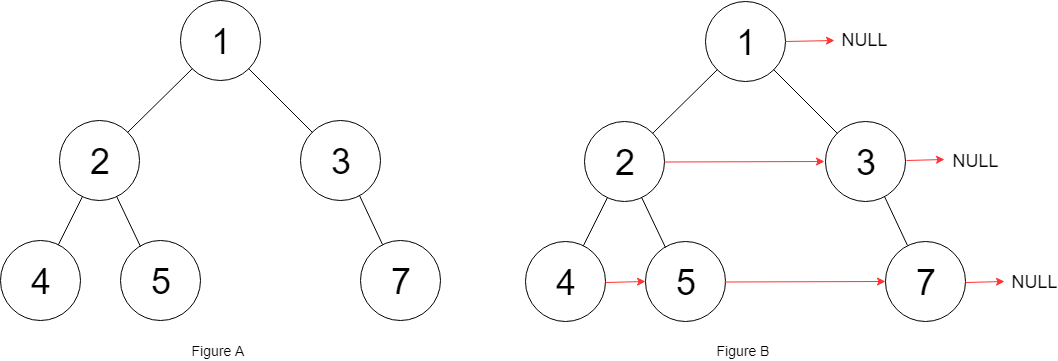第10天了。
今天的题目是 117. Populating Next Right Pointers in Each Node II :
Given a binary tree
1struct Node {2 int val;3 Node *left;4 Node *right;5 Node *next;6}Populate each next pointer to point to its next right node. If there is no next right node, the next pointer should be set to NULL.
Initially, all next pointers are set to NULL.

Example:
1Input: {"$id":"1","left":{"$id":"2","left":{"$id":"3","left":null,"next":null,"right":null,"val":4},"next":null,"right":{"$id":"4","left":null,"next":null,"right":null,"val":5},"val":2},"next":null,"right":{"$id":"5","left":null,"next":null,"right":{"$id":"6","left":null,"next":null,"right":null,"val":7},"val":3},"val":1}2
3Output: {"$id":"1","left":{"$id":"2","left":{"$id":"3","left":null,"next":{"$id":"4","left":null,"next":{"$id":"5","left":null,"next":null,"right":null,"val":7},"right":null,"val":5},"right":null,"val":4},"next":{"$id":"6","left":null,"next":null,"right":{"$ref":"5"},"val":3},"right":{"$ref":"4"},"val":2},"next":null,"right":{"$ref":"6"},"val":1}4
5Explanation: Given the above binary tree (Figure A), your function should populate each next pointer to point to its next right node, just like in Figure B.Note:
- You may only use constant extra space.
- Recursive approach is fine, implicit stack space does not count as extra space for this problem.
这是一道之前没做出来的问题,最开始想出来的解法也和之前差不多,大概的想法是递归求解时返回子树的最左和最右节点,然后通过一些判断来相连,但是这个问题主要是没法处理两个子树高度不一样的问题。
后面尝试用分治的方法来做,主要的想法是,假设我现在已经有了连接好的左子树和右子树,现在只需要将两个子树连接起来即可。而连接方法就是一层一层的去连接两个子树:
1Node *nextLayer(Node *root) {2 while(root) {3 if (root->left) return root->left;4 if (root->right) return root->right;5 root = root->next;6 }7 return nullptr;8}9void connectLeftRight(Node *left, Node *right) {10 // level 111 Node *pl, *pr;12 while(left && right) {13 pl = left;14 pr = right;15
17 collapsed lines
16 // next layer17 left = nextLayer(left);18 right = nextLayer(right);19
20 // connect left and right tree in this layer21 while(pl->next) pl = pl->next;22 pl->next = pr;23 }24}25
26Node* connect1(Node* root) {27 if (root == nullptr) return nullptr;28 Node *left = connect1(root->left);29 Node *right = connect1(root->right);30 connectLeftRight(left, right);31 return root;32}这个方法的时间复杂度大概是O(h^2),其中h是树的高度。
后面又发现一种方法,这种方法大概的思路是连接孩子,然后在递归求解。这样会保证在求解到root节点时,root节点的next是已知的,同时在连接孩子时,需要利用到右子树的next指针,所以需要先求解右子树再求解左子树。
1void connectChild(Node *root) {2 if (root == nullptr) return;3
4 if (root->left) {5 if (root->right) root->left->next = root->right;6 else root->left->next = helper(root->next);7 }8 if (root->right) {9 root->right->next = helper(root->next);10 }11
12}13
14Node *helper(Node *root) {15 if (root == nullptr) return nullptr;13 collapsed lines
16 else if (root->left) return root->left;17 else if (root->right) return root->right;18 else return helper(root->next);19}20
21Node* connect2(Node* root) {22 if (root ==nullptr) return nullptr;23 connectChild(root);24 // 先求右边的。25 connect2(root->right);26 connect3(root->left);27 return root;28}